Wildflowers, Grasses and Other Nonwoody Plants
Media

Species Types
Scientific Name
Scutellaria incana
Description
Showy clusters of blue-violet, two-lipped flowers adorn downy skullcap. This native mint is found mostly in the southern half of the state.
Media
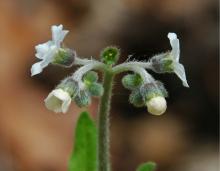
Species Types
Scientific Name
Cynoglossum virginianum
Description
Wild comfrey has large basal leaves that are soft, hairy, and elliptical with long petioles — they look like hounds’ tongues! The upright flowering stalk has few leaves and looks like a wand.
Media
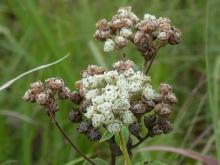
Species Types
Scientific Name
Parthenium integrifolium
Description
A common component of high-quality upland prairie, American feverfew, or wild quinine, is a native wildflower that was used to treat fevers or malaria. It's in the composite family.
Media

Species Types
Scientific Name
Antennaria parlinii
Description
Plainleaf pussytoes, named for its fuzzy flower heads, is one of the few flowering plants in Missouri that grows well in dry and shaded areas. It’s also an indicator of acid soils.
Media

Species Types
Scientific Name
Lippia lanceolata (formerly Phyla lanceolata)
Description
Common in almost any kind of moist, wet or muddy habitat, fog fruit bears interesting round, purple flower heads that are ringed by small, white or pinkish flowers.
Media
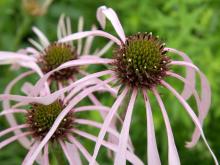
Species Types
Scientific Name
Echinacea pallida
Description
One of Missouri's five types of echinacea, pale purple coneflower is distinguished by its white pollen, drooping pink or purple ray flowers, and narrow, tapering leaves. It occurs nearly statewide, except for the Bootheel lowlands.
Media
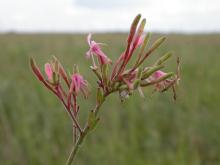
Species Types
Scientific Name
Oenothera filiformis (formerly Gaura longiflora, G. biennis)
Description
Large-flowered gaura is a tall plant whose white flowers turn pinkish as they age. Four petals point upward, then bend back, and 8 stamens droop downward. The flowers look something like small butterflies.
Media

Species Types
Scientific Name
Symphyotrichum oblongifolium (formerly Aster oblongifolius)
Description
Oblong-leaved, or aromatic aster, is well-named. It is notable for its fragrant foliage and its crowded, stalkless, clasping, hairy, narrow, oblong leaves. Like our other native asters, it blooms in late summer and fall.
Media
Species Types
Scientific Name
Erigeron philadelphicus
Description
The antique belief that this plant might repel fleas gives the fleabanes their name. There are more than 170 fleabanes in the genus Erigeron in North America. This one is scattered to common nearly throughout Missouri. Native Americans used this species medicinally for a variety of ailments.
Media
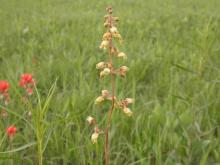
Species Types
Scientific Name
Heuchera richardsonii
Description
Prairie alum root lifts its small, greenish, bell-shaped flowers high on a hairy stalk. The leaves are all in a basal clump, have long stalks, and look a bit like maple leaves.
See Also
About Wildflowers, Grasses and Other Nonwoody Plants in Missouri
A very simple way of thinking about the green world is to divide the vascular plants into two groups: woody and nonwoody (or herbaceous). But this is an artificial division; many plant families include some species that are woody and some that are not. The diversity of nonwoody vascular plants is staggering! Think of all the ferns, grasses, sedges, lilies, peas, sunflowers, nightshades, milkweeds, mustards, mints, and mallows — weeds and wildflowers — and many more!





















